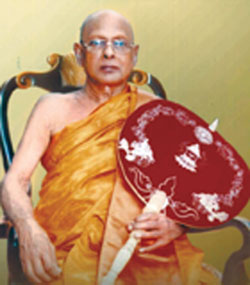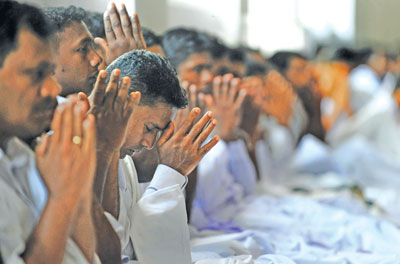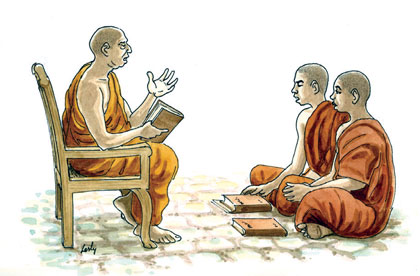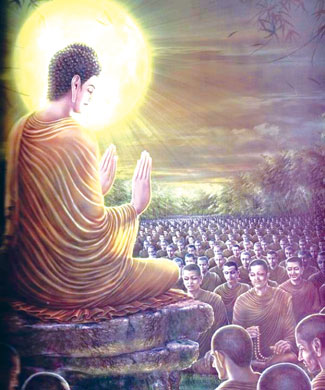|
BUDDHIST SPECTRUM
Hatred-free mind, free of discomforts
Samangie WETTIMUNY
Agga Maha Panditha Most Venerable Bellana Gnanawimala Thera is
interviewed by the Daily News Buddhist Spectrum on timely topics related
to the Dhamma.
 |
|
Agga Maha
Panditha Most Venerable
Bellana Gnanawimala Thera |
Q: Should a Buddhist stick to a vegetarian diet?
A: Killing a living being is a violation of the first precept.
As the Buddha said an individual's consumption of meat cannot be
considered a sin if the person is not involved with the killing of that
animal. Depending on the fulfillment of the following three conditions
an individual may consume meat.
1. If you did not see the animal being slaughtered for your
consumption.
2. If you did not hear that the animal was slaughtered for your
consumption.
3. If it is not implied in anyway that the animal was killed for you,
and you did not have even the slightest impression about it.
Monks have to depend on what is offered to them as alms. Imagine a
situation where I was offered a meat curry at an alms-giving. Here
neither I was involved with the killing nor was I aware that I'll be
offered a meat curry as a part of my alms. In such an instance it cannot
be called a sin.
The issue had been extensively discussed in the Vinaya books, the
Discipline Code. During the time of the Buddha one of the Vinaya rules
Devatdatta Thera wanted the Buddha to impose on the Sangha was to
prohibit meat consumption. The Buddha did not agree with him. The reason
is that monks cannot prepare their own meals, but have to depend on what
they get while going on alms rounds (Pindapatha). They cannot choose
their own food.
Q: Practising Metta meditation properly is said to bring
immense benefits. How should one make use of it when dealing with
difficult and ill mannered people in society?
A: The power of Metta is unlimited. Metta is a feeling of
compassion born in your mind which is being felt by the person on whom
you bestow it. If you develop compassion towards your enemy, that
person's level of hatred will begin to cease gradually. You have to
practise this methodically. Merely reciting verses won't do.
According to the Buddhist Literature the infuriated elephant Nalagiri
was tamed by the Buddha with the power of extreme compassion.
Imagine a situation where you want to guide a person who has
induldged in bad behaviour back to the right path. However unpleasant
his/her sight might be, you should treat him with compassion and should
always wish for his/her success. To observe good results you should
create a practice routine. By continuously doing so you may be able to
see a positive change in that person. Even in a situation where your
subject is not in your close proximity, positive results could be
observed by developing extreme compassion towards him/her.
Q: Anger management is a must when living in a society where
you meet different types of people. But we often observe people getting
into quarrels even over petty issues.
 |
|
If you develop compassion towards your
enemy, that personís level of hatred will begin to cease
gradually |
A: Mind is the fore-runner of all the conditions. You should
always position yourself in the mind of the person who gets subjected to
harassment and then you will understand what as unpleasant experience it
is to be a victim of somebody else's anger. Just as you do not like to
get harassed the other person too would not like it. Take yourself as an
example and do not hurt others.
If someone is trying to harass or hurt you, try not to develop hatred
towards him. Just think that h/she would have been your relative or
close friend in one of your previous births which would mean it is not
proper do bear malice towards him/her even though that person is harsh
on you.
Out-of-control anger can lead to stress and other health hazards such
as high blood pressure.
Q: Most of the time, the devotees do not know the meaning of
the sutras they recite as they are in Pali. Will this bring the maximum
results?
A: Knowing the meaning of what you recite will definitely
bring better results. However even if you do not know the full meaning
of the Gathas or Pirith, it will bring results when you recite or chant
them with great veneration.
Q: Family Planning Methods are used by most families to limit
the number of children born. What is the Buddhist interpretation?
A: Destroying a living being is a sin. Here what is done is
controlling the chances of conception. It cannot be considered a sin.
Q: However if all resort to these birth-control methods would
it not have a negative effect?
A: Not to a great extent. If there is a hindrance in one place
the Gandhabbha will choose another womb.
Education of the Buddhist monks
E M G Edirisinghe
University is the seat of higher learning for the youth. Is it so for
the young Buddhist monks too? One of the principal developments that
caused harm immensely to the community of Buddhist monks is the
admission of them into the universities which are dominated by lay
students and their activities. While we regret and lament over this
historical and educational blunder we should condemn every
administration that followed for failure to have taken steps to rectify
this mistake in the name of Buddhism the greatest gift we as Sri Lankans
do could offer to the world at large.
 The students monks cannot be categorized on par with the lay students
because each belongs to a different group of discipline with the monks
ranking above the rest in all aspects that ensures a morally exemplary
character. Their mental discipline, physical conduct and public life is
determined by the Vinaya rules which are far superior to those which are
applicable to the layman's discipline. The relevant Vinaya rules develop
them into a category of men of a class of their own which is superior to
the disposition expected of the lay student. The students monks cannot be categorized on par with the lay students
because each belongs to a different group of discipline with the monks
ranking above the rest in all aspects that ensures a morally exemplary
character. Their mental discipline, physical conduct and public life is
determined by the Vinaya rules which are far superior to those which are
applicable to the layman's discipline. The relevant Vinaya rules develop
them into a category of men of a class of their own which is superior to
the disposition expected of the lay student.
Adherence to Vinaya rules is a challenge, and non-commitment to
respect them, indiscipline is inevitable. And, when they are made to
move freely with the lay students, both male and female whose code of
discipline is less rigourous, the monks when moving freely, naturally
the tendency would be to turn out to be laymen in robes. The subjects
both groups of students study could be common to all, but how they
should conduct themselves in certain areas is wide apart and the path
they have to take too, is different.
If the government or the society allow the monks to degenerate
themselves into a low lay-level discipline with which we are familiar
today, it would be disastrous to the spiritual development of the people
whose conduct and character should be moulded by the religion they
believe in.
Sangha is one of the three gems of refuge, the Buddhists take
shelter. However, the Sangha whom we honour and worship as one of the
triple gems does not include the 'Sammatha Sangha' whom we meet in the
campus or in the temples, but the 'Arya Sangha' meaning the Arahants.
They are those who have reach the last lap in their sansaric (cycle
of births) journey. The former category of the Sangha in general, is a
symbolic representation of the latter realized through leading a
righteous life in their role as the Buddhist clergy. University is not
the ideal ground where this development or goal could be realized.
The subjects the Buddhist monks should study should be those which
enrich themselves in the knowledge and practice of the Dhamma in
accordance with the Dhamma rules in the Vinaya Pitakaya. If they are to
select subjects the way the laymen do select subjects as they have to
seek jobs and bring up a family, the unique distinct moral and social
existence of the monks will disappear from their disposition.
They should learn Buddhism and Pali at their highest standard
together with such subjects as History, Buddhist civilization, English
and other main religions. Then they will be intellectually equipped to
meet the moral, spiritual and social challenges they have got to face in
society.
To be continued
The Buddha, the greatest psychologist
Dr Senarath Tennakoon
The Buddha has declared that the human mind is luminous
(pabahassaram), but it is defiled by intrusive (ugantukehi) defilements
(Anguttara Nikaya). In the Dhammapada it is stated that in every human
action the mind is the forerunner (Mano pubbangama Dhamma-Mano setta
manomaya).
 "O Monks, this subconscious mind is radiant, clear and lucid. It gets
contaminated with the blemishes that come from outside", declared the
Buddha (in Anguttara Nikaya). "O Monks, this subconscious mind is radiant, clear and lucid. It gets
contaminated with the blemishes that come from outside", declared the
Buddha (in Anguttara Nikaya).
There is no entity that is greater or more powerful than the mind.
All the wonders and the so called miracles and scientific developments
are the achievements of developed minds. Buddhists believe that the
state of supreme bliss (Nibbana) too is a mental phenomena, a state of
mind that arises when craving has been totally eradicated from the mind.
But according to Buddhism to be a perfect human being there are two
important qualities that should be inculcated. These are compassion or
loving kindness and wisdom or a heart cooled with compassion and
ignorance being dispelled by wisdom. In brief one should extend loving
kindness to all beings and one should have a perfect knowledge of all
disciplines that are essential for life.
The Buddha never asked his disciples and the followers to perform
magical deeds or miracles. Once when the Buddha was in the mango grove
Pavarika, near Nalanda a householder called Kevaddha informed the Buddha
that the people of Nalanda would admire if His disciples could perform
some miracles. The Buddha offered him a straightforward reply and
declared.
"Kevaddha, I never ask my disciples to perform miracles demonstrating
higher mental power for the benefit of the ordinary layman." It is said
that Kevaddha requested the Buddha thrice and the Buddha declined
thrice. It is well-known what the Buddha told his disciples who have
seen an ascetic who walked over water to cross a river. The Buddha asked
the ferryman who worshipped the Buddha after returning from a trip
across the river "How much do you charge as your fare?"
The ferryman replied that he charges half a masaka (Addhamasakka)
which is a coin of low value. The Buddha turned to his disciples who
wanted the Buddha to do a miracle and declared. "The ascetic's miracle
is worth half a masaka. He could have mortified his body for a long
period of time to achieve that yogic power. Why should I waste my
valuable time that I have to use for the well-being of the people to
perform a task that is worth only half a masaka? (Sarada, 1998). He
declared that every person is a potential Buddha.
His advice is for self-development without depending on a third party
development. Further the Buddha extolled the importance of observing the
principle of practicing four treasures of giving namely making donations
(dana), gentle speech (priya vachanaya), equality (Samanathmathawaya)
and economic effort (Artha chariyava) in day-to-day lively activities. A
Buddhist has to follow the Noble Eightfold Path, be aware of the three
key features (Impermanence, suffering and soullessness) of life and the
five laws (Pancha Niyama) of existence while contemplating on the law of
causation (Patticca Sammupada) and engage in meditation for striving
towards Nibbana by eliminating all evil.
The greatness of the Buddha lies in another aspect as He respected
the freedom of the human mind. The Buddha has declared that one should
not believe in anything simply because one has heard of it, it has been
handed down from generation to generation (tradition and convention),
because others believe in it, it is documented in religious books, or as
told by ones teachers, elders and those in authority. One should observe
and analyze by ones own effort and mind reason it out to accept or to
reject it. This issue is well described in Anguttara Nikaya.
Most revered Dalada
S B Karalliyadda
The Dalada was brought to Lanka in the ninth year of the reign of
Kithsirimevan. Since then the Dalada perahera has been held annually for
about one thousand seven hundred years up to now uninterrupted. Even
during periods of invasions from Soli, Pandi, Kerala, Portuguese, Dutch,
English and the JVP insurrection the perahera pageant was held observing
the customs, traditions and rituals associated with this event.
 |
|
The ancient
view of Dalada Maliga |
Though there are various other relics of the Buddha enshrined in
several dagabas or pagodas throughout the island, there is no other
relic of the Buddha that is held in such veneration and respect as the
Tooth Relic in Senkadagala. Why is the Tooth Relic held in such
veneration and a holy object by the Buddhists throughout the world. The
sanctity it commands and deserves is due to many unique qualities of
this sacred object.
Unique features
It is a common and accepted belief that it has divine powers. When
there were prolonged droughts the ancient kings invoked the blessings of
the Dalada to bring rains. History records of instances when the kings
made offerings and fasts to bring rains. Even during the British rule an
occasion is recorded where the Mahaweli was flooded and the devotees
from Harispattu areas were unable to cross the river to come to
Senkadagala. During the Dambadeniya Parakamabahu's reign the Tooth Relic
performed a miracle by rising in the sky drawing the attention of the
king and the people and finally settling down in a golden bowl offered
by the king.
Queen Sugala
The relics showered its rays at this moment as mentioned in the
Mahawansa. It was the belief among the Lankans that the ruler of the
time should be the custodian of the Relic. No ruler who was not the
custodian of the Relic was accepted as their king. When Maha
Parakramabahu was the king in Polonnaruwa, Queen Sugala escaped to
Rohana with the Tooth Relic. Parakramabahu's army recovered the relic
near Ethimale in the present Moneragala electorate and the king held his
second coronation having the relics in his possession and thus gaining
people's acceptance as their king.
This is the reason why successive kings took the relics to their
custody. When the kingdom changed to Dambadeniya, Yapahuwa, Kurunegala,
Gampola, Kotte and Senkadagala the relic was taken to these capitals and
kept in a Dalada Maligawa built for this purpose. The ruins of these
edifices could be seen even today. With the Dalada we inherited a
building architecture. Watadage, atadage, hetadage, etc are some of
these architectural remains. The Sinhala language and literature was
enriched with writings such as Dalada Siritha. Lord Buddha's palate and
jaw are unique, in that no other human being had forty teeth in the
dentition except the Buddha. All these teeth were uniquely and
symmetrically positioned according to Budugunalankaraya.
While human teeth are identified as incisors, canines, molars and
pre-molars, Lord Buddha's super human being teeth, are identified as
sukla danta, chattarisath danta, sama danta and avivara danta. Naraseeha
gatha confirms this.
Because of his teeth when the Buddha preaches he emanates a pleasant
and soothing melody. The is the Brahmaswara Lakshana.
Buddha's blessings bestowed long life to God Sakka when he was
nearing his life span. This incident is described in Seul Sandesaya.
It is believed that the gods and all celestial beings came daily to
Kotte Dalada Maligawa to worship the Tooth Relic. Such are the divine
powers of this holy object of worship which occupies the foremost
position among the Buddha's relics which has won the acceptance of the
Buddhists world over.
Journey to Senkadagala
Selalihini Sandesaya says it is the Buddha's teeth that first feels
the blessings of the oral preachings of Dhamma by the Lord Buddha.
Many attempts were made by foreign invaders to capture the relic and
keep in their possession by foreign powers, but all such attempts were
foiled by our ancestors.
The tooth relic was brought to Abayagiri Vihara in Anuradhapura
during the ninth year of the reign of Kithsirimevan (303-331 BC). The
left tooth relic of the Buddha was in possession of king Guhaseeva of
Kalinga Desh, now Orissa. When the king faced a threat of invasion by a
rival he sent the relics to his friend Mahasen who was the king of Lanka
at the time with his daughter Hemamala and son-in-law Prince Dantha.
When the relics arrived here Mahasen was dead and his son received
the relics, who kept the sacred object in Abhayagiri Vihare and annually
held the Dalada Perahera which has now become an annual religious
pageant during the past one thousand seven hundred odd years.
There is no other Esala pageant that can be equal to this supreme and
unique religio-cultural pageant held in the Senkadagala kingdom. From
the time that the country was freed from Maga invasion by Bodiraja of
Galahitiyawa in the present Udadumbara who assumed kingship as
Wijayabahu III in 1232 AD the successive kings who protected the Tooth
Relic in Beligala Dambadeniya, Yapahuwa, Kurunegala, Gampola, Kotte and
finally in Senkadagala, Weera Parakramabahu Narendrasinghe of Kundasale
up to 1749 for a period of over five hundred years are from Dumbara
which is today divided as Uda Dumbara, Patha Dumbara, Meda Dumbara, etc
for administrative purposes.
Dalada perahera
The festival season of the Sinhala starts with the month of Bhagiya
(luck) month of Bak which is today the month of April. It is the month
in which farmers collect the harvests of grains such as paddy, millet
(kurahan - eleusine coralana), meneri (penicum miliare), Indian corn
(zea mays or iringu) etc. and store them for future use. It is in this
month that we celebrate the Sinhala/Hindu new year festival.
To be continued
|





